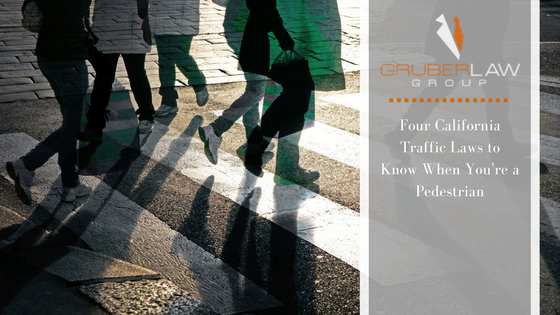Pedestrians have relatively robust legal protections in the state of California, especially in San Francisco, but they are not invincible. In many instances, the same laws that instruct vehicles also serve to caution pedestrians against engaging in reckless behavior or from presenting an “immediate hazard” to others.
To help you understand your personal rights and when a pedestrian accident attorney may be needed to help you seek compensation for an injury, consider the following four California pedestrian laws below:
Pedestrians Have Right-of-Way at Crosswalks (CVC §21950, a, c)
The first law to lay down as a ground rule is California Vehicle Code §21950, which states that all vehicles “shall yield right-of-way” to all pedestrians currently crossing the road at a marked crosswalk or an unmarked crosswalk at an intersection.
The law even goes on to state that vehicles “shall exercise all due care and shall reduce the speed of the vehicle or take any other action relating to the operation of the vehicle as necessary to safeguard the safety of the pedestrian,” providing a nice clarification to what “yield right-of-way” should mean in a typical situation. Vehicles cannot put just a partial effort into yielding, but rather have to “exercise all due care,” making many excuses like “I slowed down to a near stop but still hit them,” not as defensible.
Pedestrians Should Not “Constitute an Immediate Hazard” (CVC §21950, b)
On the flip side of the above statute is its subsection b, which states that “no pedestrian may suddenly leave a curb or other place of safety and walk or run into the path of a vehicle that is so close as to constitute an immediate hazard.”
While what may “constitute an immediate hazard” is up for debate, this law does state that pedestrians must exercise caution even if they do explicitly have the right-of-way in a situation. If a pedestrian anticipates that a vehicle cannot stop in time but they walk into a street anyway, the law recognizes their role in presenting a hazard.
Commonly, juries or insurers will get into debates about who shares liability in such situations, whether the driver had time to react and whether the pedestrian should have anticipated that they were creating a hazard.
Jaywalkers Should Not “Constitute an Immediate Hazard” (CVC §21954, a)
Pedestrians crossing at a non-designated crosswalk or not an intersection, which could be called “jaywalking” under some legal definitions, must yield right-of-way to drivers and not create “an immediate hazard” through their crossing.
Similarly, CVC §21456 states that pedestrians given a WALK sign or “walking person” symbol can proceed, but must yield right-of-way to vehicles already in the crosswalk at the time they intend to enter. They must also avoid entering the intersection when a “DON’T WALK,” “WAIT” or approved “Upraised Hand” symbol is shown.
Drivers Cannot Ignore the Safety of Jaywalkers (CVC §21954, b)
Even when people fail to yield the right-of-way as instructed by CVC §21954(a), their actions “shall not relieve the driver of a vehicle from the duty to exercise due care for the safety of any pedestrian upon a roadway,” according to 21954 subsection b.
In other words, a pedestrian breaking the law or creating a hazard does not give a driver carte blanche to ignore the pedestrian’s personal safety. They must instead exercise “due care,” which is often interpreted to mean the maximum amount of care a reasonable person could reasonably exercise in the given situation. Even though a person may be “jaywalking”, a driver is always responsible for observing the conditions in front of their vehicle and may share liability even if the injured pedestrian is placed “at fault” in the police report.
The Need for a Pedestrian Accident Attorney When Things Get Confusing
The above laws create a surprising amount of gray areas in many pedestrian accident cases, leaving situations open to interpretation and subject to the available evidence for the accident.
Pedestrians have a right to pursue compensation for their injuries even in situations where they share fault, and they also have a right to dispute the alleged at-fault driver’s interpretation of events. They can work with a San Francisco pedestrian accident lawyer to examine the details of their case and put forth their version of events in the most compelling way possible, increasing their chances of recovering damages for their injury.










ROBERT H. TOURTELOT, ESQ
Question: Dioes CVC sect. 21950 apply in a public parking lot when client (pedestrian) is crossing at an unmarked crosswalk which intersects within the public parking llot at the roadway within the parking lot? Thanks. Need asap as trial starts 4/30 Defense says it has two cases which say thatCVC does not apply in a public parking lot. Defendant was speeding and hit client as he was walking across unmarked cross way. Thanks, Bob Tourtelot